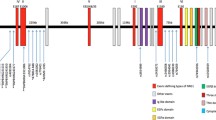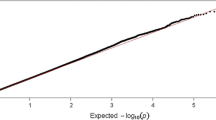Abstract
Cerebral infarction disease is a severe hypoxic ischemic tissue necrosis in the brain, often leading to long-term functional disability and residual impairments. The Notch signaling pathway plays key roles in proliferation and survival of the stem/progenitor cells of the central and peripheral nervous systems. Notch3 is an important member of the pathway, but the relationships between the genetic abnormalities and cerebral infarction disease still remain unclear. The aim of this work was to evaluate variations in Notch3 gene for their possible associations with the cerebral infarction disease. We sequenced the Notch3 gene for 260 patients with cerebral infarction disease, 300 normal controls with old ages and 300 normal controls with younger ages, and identified the variations. The statistical analyses were conducted using Chi-Square Tests as implemented in SPSS (version 19.0). The Hardy-Weinberg equilibrium test of the population was carried out using the online software OEGE. Six variations, including rs1044116, rs1044009, rs1044006, rs10408676, rs1043996 and rs16980398 within or near the Notch3 gene, were found. The genetic heterozygosity of rs1044116, rs1044009, rs1044006, and rs1043996 was very high, whereas that of rs10408676 and rs16980398 was very low. Statistical analyses showed that rs1044009 and rs1044006 were associated with the risk of cerebral infarction disease in the Chinese Han agedness population. The SNPs rs1044009 and rs1044006 in the Notch3 gene were associated with the risk of cerebral infarction diseases in the Chinese Han agedness population.


Similar content being viewed by others
References
Aoki J, Kimura K, Iguchi Y, et al. (2010) FLAIR can estimate the onset time in acute ischemic stroke patients. J Neurol Sci 293:39–44
Chung AS, Ferrara N (2011) Developmental and pathological angiogenesis. Annu Rev Cell Dev Biol 27:563–584
Daemen MA, Van 'T Veer C, Denecker G, et al. (1999) Inhibition of apoptosis induced by ischemia-reperfusion prevents inflammation. J Clin Invest 104:541–549
Deng X, Zhou J, Li FF, et al. (2014) Characterization of nodal/TGF-lefty signaling pathway gene variants for possible roles in congenital heart diseases. PLoS One 9(e104535)
Domenga V, Fardoux P, Lacombe P, et al. (2004) Notch3 is required for arterial identity and maturation of vascular smooth muscle cells. Genes Dev 18:2730–2735
Eguchi K, Kario K, Shimada K (2003) Greater impact of coexistence of hypertension and diabetes on silent cerebral infarcts. Stroke 34:2471–2474
Ehebauer M, Hayward P, Martinez-Arias A (2006) Notch signaling pathway. Sci STKE 2006(cm7)
Epelbaum S, Benisty S, Reyes S, et al. (2011) Verbal memory impairment in subcortical ischemic vascular disease: a descriptive analysis in CADASIL. Neurobiol Aging 32:2172–2182
Fischer A, Schumacher N, Maier M, et al. (2004) The notch target genes Hey1 and Hey2 are required for embryonic vascular development. Genes Dev 18:901–911
Fugate JE, Rabinstein AA (2015) Absolute and Relative Contraindications to IV rt-PA for Acute Ischemic Stroke. Neurohospitalist 5:110–121
Gjerde G, Naess H (2014) Risk factor burden predicts long-term mortality after cerebral infarction. Acta Neurol Scand 129:173–177
Gong Z, Zhao S, Zhang J, et al. (2016) Initial research on the relationship between let-7 family members in the serum and massive cerebral infarction. J Neurol Sci 361:150–157
Han KT, Park EC, Kim SJ, et al. (2015) Effective strategy for improving health care outcomes: multidisciplinary care in cerebral infarction patients. Health Policy 119:1039–1045
Herve D, Chabriat H (2010) Cadasil. J Geriatr Psychiatry Neurol 23:269–276
Jeong HS, Song HJ, Kim SB, et al. (2013) A comparison of stent-assisted mechanical thrombectomy and conventional intra-arterial thrombolysis for acute cerebral infarction. J Clin Neurol 9:91–96
Jiang XH, Lin KX, Zhang YX, et al. (2015) Correlating interleukin-10 promoter gene polymorphisms with human cerebral infarction onset. Neural Regen Res 10:1809–1813
Joutel A, Andreux F, Gaulis S, et al. (2000) The ectodomain of the Notch3 receptor accumulates within the cerebrovasculature of CADASIL patients. J Clin Invest 105:597–605
Jouve C, Palmeirim I, Henrique D, et al. (2000) Notch signalling is required for cyclic expression of the hairy-like gene HES1 in the presomitic mesoderm. Development 127:1421–1429
Khatri P, Abruzzo T, Yeatts SD, et al. (2009) Good clinical outcome after ischemic stroke with successful revascularization is time-dependent. Neurology 73:1066–1072
Kouakam C, Guedon-Moreau L, Lucas C, et al. (2000) Long-term evaluation of autonomic tone in patients below 50 years of age with unexplained cerebral infarction: relation to atrial vulnerability. Europace 2:297–303
Krebs LT, Xue Y, Norton CR et al. (2000) Notch signaling is essential for vascular morphogenesis in mice. Genes Dev 14:1343–1352
Lawson ND, Weinstein BM (2002) Arteries and veins: making a difference with zebrafish. Nat Rev Genet 3:674–682
Lawson ND, Scheer N, Pham VN, et al. (2001) Notch signaling is required for arterial-venous differentiation during embryonic vascular development. Development 128:3675–3683
Li L, Xie T (2005) Stem cell niche: structure and function. Annu Rev Cell Dev Biol 21:605–631
Li FF, Liu Z, Yan P, et al. (2015a) Identification of a novel mutation associated with familial adenomatous polyposis and colorectal cancer. Int J Mol Med 36:1049–1056
Li FF, Han Y, Shi S, et al. (2015b) Characterization of Transcriptional Repressor Gene MSX1 Variations for Possible Associations with Congenital Heart Diseases. PLoS One 10(e0142666)
Li FF, Zhou J, Zhao DD, et al. (2015c) Characterization of SMAD3 Gene variants for possible roles in ventricular septal defects and other congenital heart diseases. PLoS One 10(e0131542)
Liao SJ, Gong Q, Chen XR, et al. (2013) Netrin-1 rescues neuron loss by attenuating secondary apoptosis in ipsilateral thalamic nucleus following focal cerebral infarction in hypertensive rats. Neuroscience 231:225–232
Ling L, Zeng J, Pei Z, et al. (2009) Neurogenesis and angiogenesis within the ipsilateral thalamus with secondary damage after focal cortical infarction in hypertensive rats. J Cereb Blood Flow Metab 29:1538–1546
Liu N, Zhang Y, Fan L, et al. (2011) Effects of transplantation with bone marrow-derived mesenchymal stem cells modified by Survivin on experimental stroke in rats. J Transl Med 9:105
Liu Y, Zhang Y, Lin L, et al. (2013a) Effects of bone marrow-derived mesenchymal stem cells on the axonal outgrowth through activation of PI3K/AKT signaling in primary cortical neurons followed oxygen-glucose deprivation injury. PLoS One 8(e78514)
Liu X, Mei Z, Qian J, et al. (2013b) Puerarin partly counteracts the inflammatory response after cerebral ischemia/reperfusion via activating the cholinergic anti-inflammatory pathway. Neural Regen Res 8:3203–3215
Louis S, Mcdowell F (1970) Age: its significance in nonembolic cerebral infarction. Stroke 1:449–453
Maillard I, Fang T, Pear WS (2005) Regulation of lymphoid development, differentiation, and function by the Notch pathway. Annu Rev Immunol 23:945–974
Nowak DA (2008) The impact of stroke on the performance of grasping: usefulness of kinetic and kinematic motion analysis. Neurosci Biobehav Rev 32:1439–1450
Ohtsuka T, Ishibashi M, Gradwohl G, et al. (1999) Hes1 and Hes5 as notch effectors in mammalian neuronal differentiation. EMBO J 18:2196–2207
Penton AL, Leonard LD, Spinner NB (2012) Notch signaling in human development and disease. Semin Cell Dev Biol 23:450–457
Popa-Wagner A, Buga AM, Doeppner TR, et al. (2014) Stem cell therapies in preclinical models of stroke associated with aging. Front Cell Neurosci 8:347
Ross OA, Soto-Ortolaza AI, Heckman MG, et al. (2013) NOTCH3 variants and risk of ischemic stroke. PLoS One 8(e75035)
Rutten-Jacobs LC, Traylor M, Adib-Samii P, et al. (2015) Common NOTCH3 Variants and Cerebral Small-Vessel Disease. Stroke 46:1482–1487
Sam C, Li FF, Liu SL (2015) Inherited neurovascular diseases affecting cerebral blood vessels and smooth muscle. Metab Brain Dis 30:1105–1116
Schmidt H, Zeginigg M, Wiltgen M, et al. (2011) Genetic variants of the NOTCH3 gene in the elderly and magnetic resonance imaging correlates of age-related cerebral small vessel disease. Brain 134:3384–3397
Shawber CJ, Kitajewski J (2004) Notch function in the vasculature: insights from zebrafish, mouse and man. BioEssays 26:225–234
Shen Z, Hou X, Chen B, et al. (2015) NOTCH3 gene polymorphism is associated with the prognosis of gliomas in Chinese patients. Medicine (Baltimore) 94(e482)
Shi ZS, Loh Y, Walker G, et al. (2010) Endovascular thrombectomy for acute ischemic stroke in failed intravenous tissue plasminogen activator versus non-intravenous tissue plasminogen activator patients: revascularization and outcomes stratified by the site of arterial occlusions. Stroke 41:1185–1192
Shimada K, Kawamoto A, Matsubayashi K, et al. (1990) Silent cerebrovascular disease in the elderly. Correlation with ambulatory pressure. Hypertension 16:692–699
Tan ZX, Li FF, Qu YY et al. (2012) Identification of a known mutation in notch 3 in familiar CADASIL in China. PLoS One 7:e36590
Thajeb P (1993) Gait disorders of multi-infarct dementia. CT and clinical correlation. Acta Neurol Scand 87:239–242
Tu Q, Cao H, Zhong W, et al. (2014) Atorvastatin protects against cerebral ischemia/reperfusion injury through anti-inflammatory and antioxidant effects. Neural Regen Res 9:268–275
Uehara T, Tabuchi M, Mori E (1999) Risk factors for silent cerebral infarcts in subcortical white matter and basal ganglia. Stroke 30:378–382
Verdecchia P, Porcellati C, Reboldi G, et al. (2001) Left ventricular hypertrophy as an independent predictor of acute cerebrovascular events in essential hypertension. Circulation 104:2039–2044
Wang H, Guo W, Liu H, et al. (2013) Inhibition of inflammatory mediator release from microglia can treat ischemic/hypoxic brain injury. Neural Regen Res 8:1157–1168
Wang S, Zhou J, Kang W et al. (2016) Tocilizumab inhibits neuronal cell apoptosis and activates STAT3 in cerebral infarction rat model. Bosn J Basic Med Sci
Yan HQ, Yuan Y, Zhang P, et al. (2015) Association of the ApoE gene polymorphism and dietary factors with cerebral infarction and circulating lipid concentrations. Genet Mol Res 14:665–670
Yellon DM, Hausenloy DJ (2007) Myocardial reperfusion injury. N Engl J Med 357:1121–1135
Zhang C, Feng F, Zhu Y, et al. (2014) Cerebral infarction caused by pituitary apoplexy: case report and review of literature. Turk Neurosurg 24:782–787
Zhang HR, Peng JH, Zhu GY, et al. (2015a) Neuroprotective effects of Bcl-2 overexpression on nerve cells of rats with acute cerebral infarction. Genet Mol Res 14:7696–7703
Zhang MJ, Zhang X, Xu YX (2015b) Analysis on value of CT and MRI clinical application in diagnosis of middle-aged patients with multiple cerebral infarction. Int J Clin Exp Med 8:17123–17127
Zhao JH, YM X, Xing HX, et al. (2016) Associations between matrix metalloproteinase gene polymorphisms and the development of cerebral infarction. Genet Mol Res 14:19418–19424
Zhong H, Cai Y, Cheng J et al. (2016) Apolipoprotein E Epsilon 4 Enhances the Association between the rs2910164 Polymorphism of miR-146a and Risk of Atherosclerotic Cerebral Infarction. J Atheroscler Thromb
Acknowledgments
The authors thank the patients and the family members for their cooperation and participation in this study.
Author information
Authors and Affiliations
Corresponding authors
Ethics declarations
Funding
This work was supported by grants of National Natural Science Foundation of China (NSFC30870098, 30,970,119, 81,030,029), and a grant from Health and Family Planning Commission of Heilongjiang province Foundation (2016–189), a grant from Heilongjiang Innovation Research Foundation for College Students (201,610,226,096).
Competing interests
The authors have declared that no competing interests exist.
Patient consent
Obtained.
Ethics approval
Ethics Committee of Harbin Medical University.
Author contributions
Study concept or design: FFL, SLL; specimen collection: CYZ, YW; experiment: CYZ, YW, QXZ, YQ, HL, YMY, ZXY; funding: SLL; drafting/revising of manuscript: all the authors.
Additional information
Chun-Yu Zhu, Yue Wang contributed equally to this work.
Rights and permissions
About this article
Cite this article
Zhu, CY., Wang, Y., Zeng, QX. et al. Combined effects of age and polymorphisms in Notch3 in the pathogenesis of cerebral infarction disease. Metab Brain Dis 31, 1157–1164 (2016). https://doi.org/10.1007/s11011-016-9868-0
Received:
Accepted:
Published:
Issue Date:
DOI: https://doi.org/10.1007/s11011-016-9868-0




